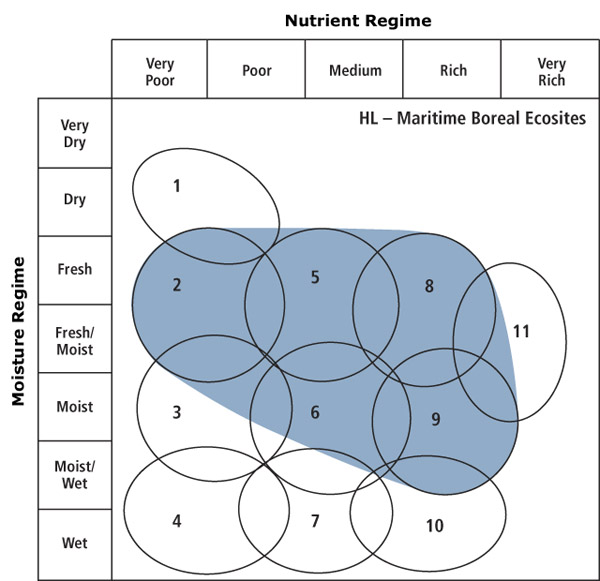
Highland Forest Group (n=51)
HL1 — Balsam fir / Mountain-ash / Large-leaved goldenrod (n=32)
HL1a —White birch / Wood sorrel variant
HL2 — White spruce / Wood aster (n=2)
HL3 — Yellow birch – Balsam fir / Eastern spreading wood fern – Wood sorrel (n=7)
HL4 — Birch / Wood fern – Wood sorrel (n=10)
Concept: The composition and vigour of highland forests are influenced by moist, cold climate conditions and exposure associated with the Cape Breton Taiga and Cape Breton Highlands ecoregions. These Vegetation Types (VT) have strong boreal affinity and are considered indicative of Maritime Boreal ecosites. Several plant species are used to indicate this highland influence. Krummholtz and wave forest conditions are also known to occur in association with highland VTs. Fact sheets for these units will be developed as more data are collected. Acadian Ecosite VTs can sometimes be found in sheltered areas within Highland ecoregion boundaries, but these are not recognized as Highland Forest group VTs.
Vegetation: Vegetation types are closed canopy forests. Softwood VTs are dominated by balsam fir and/or white spruce; with yellow birch, white birch and red maple dominating hardwood VTs. Heart-leaf birch is common throughout the group, and mountain-ash can reach tree size in some stands (both species are indicators of highland conditions). In the herb layer, the presence of large-leaf goldenrod is also indicative of this group. The bryophyte layer can be diverse, but the dominant species are Schreber's moss followed by stair-step moss and broom moss.
Environmental Setting: Vegetation types are mainly found on upper flats or upper and middle slopes of variable steepness. High winds associated with these sites generally limit tree growth to under 15 m. Most sites are non-rocky, but surface stoniness can be variable. Soils are mainly derived from glacial till or colluvium deposits. Cool, moist climate conditions slow decomposition rates resulting in sites with unusually thick duff layers. Balsam fir dominated stands form the matrix forest on the Highland plateau, with a transitional balsam fir / yellow birch mixedwood forest found on the shoulder (this mixedwood condition grades into Acadian tolerant hardwood VTs further down slope). The Highland Forest group is restricted to the Cape Breton Taiga (100) ecoregion and Cape Breton Highlands (210) ecodistrict.
Successional Dynamics: This group is associated with Maritime Boreal zonal VTs. Balsam fir dominated forests are even-aged and frequently renewed by either spruce budworm epidemics or through natural senescence (these stands seldom exceed 75 years in age). In yellow birch / balsam fir mixedwood forests, two or more age classes are common – an older yellow birch cohort and a younger balsam fir cohort. Windthrow can be extensive in hardwood dominated ecosystems creating seedbeds for both birch and balsam fir. In more exposed areas, white spruce krummholtz or balsam fir wave forest conditions can be found. Early successional stands mainly contain short-lived pioneer species (pin cherry, mountain ash, raspberry).
Ecological Features:Most ecosystems in this group are boreal, occurring at the southeastern limit of this expansive Canadian forest region. Their closest analogs are in insular Newfoundland and northern New Brunswick. This isolation is one of the group's key characteristics, with significant implications for landscape function, species persistence, migration, and ecosystem integrity. Highland forests collectively form a matrix, occupying well drained sites across the Cape Breton plateau. Balsam fir is a characteristic and often dominant tree in each of the four highland vegetation types. This tree's relatively short life span, coupled with its susceptibility to spruce budworm epidemics, strongly contributes to the dynamics and structure of the boreal landscape. Old growth conditions are largely dependent on yellow birch, supporting a distinctive birch – fir dynamic with limited distribution. The group provides habitat for a number of rare species including American marten, Canada lynx, Bicknell's thrush, boreal felt lichen and black backed woodpeckers; rare plant species are less common.
| 1a. Hardwoods >75% | HL4 Birch / Wood fern / Wood sorrel | |
| 1b. Hardwoods <75% | 2 | |
| 2a. Softwoods >75% | 3 | |
| 2b. Softwoods <75% | HL3 Yellow birch – Balsam fir / Eastern spreading wood fern – Wood sorrel | |
| 3a. Balsam fir the most common softwood | HL1 Balsam fir / Mountain-ash / Large-leaved goldenrod | |
| 3b. White spruce the most common softwood | HL2 White spruce / Wood aster | |
